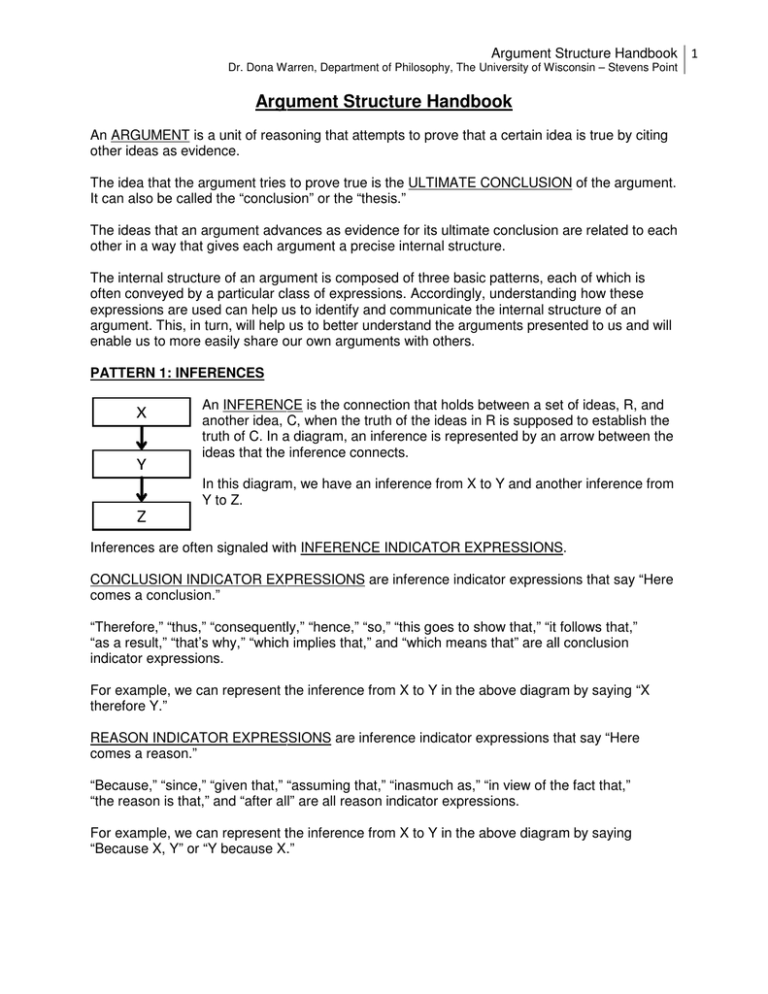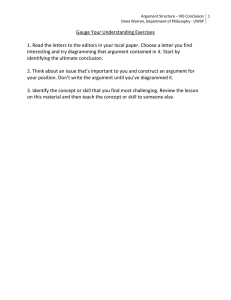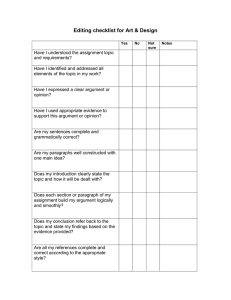Argument Structure Handbook 1
advertisement

Argument Structure Handbook 1 Dr. Dona Warren, Department of Philosophy, The University of Wisconsin – Stevens Point Argument Structure Handbook An ARGUMENT is a unit of reasoning that attempts to prove that a certain idea is true by citing other ideas as evidence. The idea that the argument tries to prove true is the ULTIMATE CONCLUSION of the argument. It can also be called the “conclusion” or the “thesis.” The ideas that an argument advances as evidence for its ultimate conclusion are related to each other in a way that gives each argument a precise internal structure. The e internal structure of an argument is composed of three basic patterns,, each of which is often conveyed by a particular class of expressions. Accordingly, understanding how these expressions are used can help us to identify and communicate the int internal ernal structure of an argument. This, in turn, will help us to better understand the arguments presented to us and will enable us to more easily share our own arguments with others. PATTERN 1: INFERENCES An INFERENCE is the connection that holds between a set of ideas, R, and another idea, C, when the truth of the ideas in R is supposed to establish the truth of C. In a diagram, an inference is represented by an arrow between the ideas that the inference connects. In this diagram, we have an inference from X to Y and another inference from Y to Z. Inferences are often signaled with INFERENCE INDICATOR EXPRESSIONS. CONCLUSION INDICATOR EXPRESSIONS XPRESSIONS are inference indicator expressions that say “Here “ comes a conclusion.” “Therefore,” “thus,”” “consequently “consequently,” “hence,” “so,” “this goes to show that,” “it follows that,” that “as a result,” “that’s why,”” “which implies that that,” and “which means that” are all conclusion con indicator expressions. For example, we can represent sent the inference from X to Y in the above diagram by saying “X therefore Y.” REASON INDICATOR EXPRESSIONS are inference indicator expressions that say “Here comes a reason.” “Because,” “since,” “given that,”” “assuming that that,” “inasmuch as,”” “in view of the fact that,” that “the reason is that,” and “after all all” are all reason indicator expressions. For example, we e can represent the inference from X to Y iin n the above diagram by saying “Because X, Y” or “Y because X.” Argument Structure Handbook 2 Dr. Dona Warren, Department of Philosophy, The University of Wisconsin – Stevens Point USING BOTH CONCLUSION N AND REASON INDICAT INDICATOR EXPRESSIONS We might use both conclusion indicator expressions and inference indicator expressions to convey an argument that has more than one inference. When this happens, we should remember that the inference indicator expression attached to the ultimate conclusion could mean that the connecting idea is the immediate reason for the ultimate conclusion or it could mean that the connecting line of reasoning is the reason for the ultimate conclusion. For example, we could write the argument in the above diagram as “Y because X. It follows that Z,” or as “Z. After all X so Y.” PREMISES AND SUBCONCLUSIONS LUSIONS Whether an idea is a premise or a subconclusion in an argument is a matter of whether or not there is an inference to the idea. evidence for the ultimate conclusion but that A PREMISE is an idea that the argument uses as evi the argument assumes to be true without providing proof proof. Accordingly, there is never an a inference to a premise. For example, X is a premise in the above argument. A SUBCONCLUSION is an intermediate idea on the way from the premises to the ultimate conclusion. The argument does give us reason to believe it and so there is always an inference to a subconclusion. For example, Y is a subconclusion in the above argument. PATTERN 2: DEPENDENT REASONS DEPENDENT REASONS are two or more ideas that are each unable to support a conclusion on its own but that can support the conclusion if taken together. In this diagram,, P and Q are dependent reasons in support of R. Dependent reasons are often connected with INFERENCE ERASER EXPRESSIONS RESSIONS, which have the function of saying that there is no inference between the ideas that they connect. If there is no contrast or tension between the dependent reasons, it’s natural to connect them with an inference eraser from rom the “and” family, which includes “and,” “m “moreover,” oreover,” “furthermore,” and “in addition.” For or example, we could say “P and Q. Therefore R.” Argument Structure Handbook 3 Dr. Dona Warren, Department of Philosophy, The University of Wisconsin – Stevens Point If there is a contrast or tension between the dependent reasons, it’s natural to connect them with an inference eraser raser from the “but family, which includes “but,” “yet,” “however,” “although,” “even though,” and “nevertheless “nevertheless.” For example, we could say “P but Q. Therefore R.” PATTERN 3: INDEPENDENT REASONS INDEPENDENT REASONS are two wo or more ideas or groups of ideas that are each able to support a conclusion on its own. They generate independent lines of reasoning. In this diagram, A and B are independent reasons in support of C. Independent reasons or lines of reasoning each have their own theme and so lines of reasoning are often indicated with THEME--CHANGER EXPRESSIONS such as “besides,” “furthermore,” “in addition to this,” “ass if that weren’t enough,” “for one thing… for another her thing…,” “first… second… third…,” and “finally.” For example, we could say “C C because A. Besides, B. B.” In an argument with only one line of reasoning, the ultimate conclusion should be placed at the beginning of the argument or at the end of the argument. In an argument with more than one line of reasoning, ng, the ultimate conclusion may be placed at the end of one line of reasoning and at the beginning of another. For example, we could say “A A therefore C. Furthermore, B. B.” COMBINATIONS OF THE THREE PATTERNS Even the most complex arguments are composed of combinations of these three basic patterns: inferences, dependent reasons, and independent reasons. Argument Structure Handbook 4 Dr. Dona Warren, Department of Philosophy, The University of Wisconsin – Stevens Point REAL LIFE APPLICATION Understanding the three basic patterns and the expressions with which they are often conveyed will make arguments much easier to understand and analyze. Nonetheless, analyzing arguments does require thought because: • Some ideas in the passage that contains an argument might not be part of the argument itself. An idea is part of the argument only if it helps to support the ultimate conclusion. Ideas that aren’t part of the argument should be ignored. • Some ideas in the argument – some premises, subconclusions, and even the ultimate conclusion – might be unstated in the passage containing the argument. If it seems clear to you that an argument includes one of these ideas, it’s okay to supply the idea yourself. • Some inferences might not be signaled with an inference indicator expression, like “therefore” or “because.” • Some dependent reasons might not be signaled with inference eraser expressions, like “and” or “but.” • Some independent reasons might not be signaled by theme changer expressions, like “besides.”





